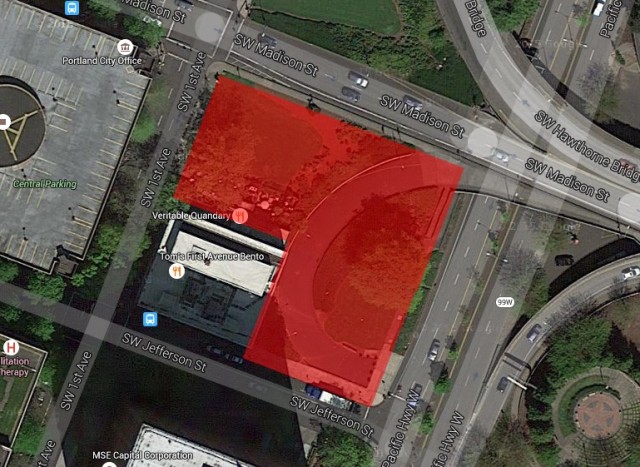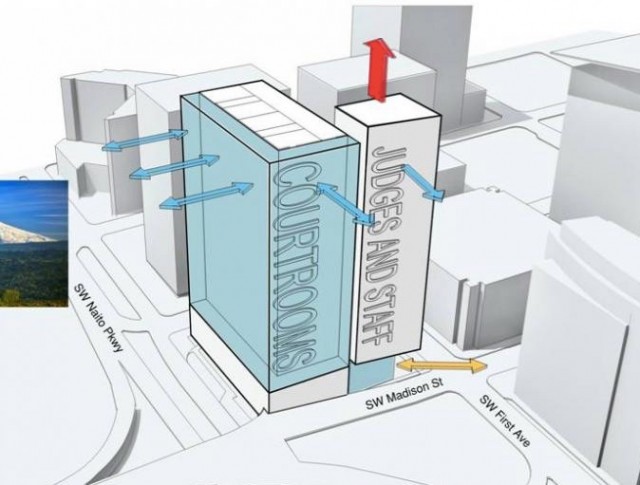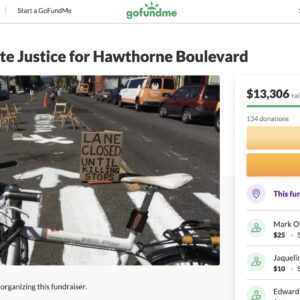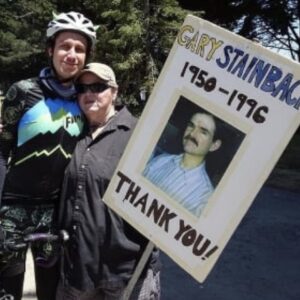
(Image: Multnomah County)
Multnomah County is planning a new central courthouse to replace the 100-year-old building they currently use on SW 4th Avenue — and it could come with a raised bike lane.
The location of the new courthouse at the corner of SE Madison and 1st Street, is very familiar to the thousands of Portlanders who ride on the Hawthorne Bridge every day. If all goes according to plan, by 2020 there will be a new 17-story building where an open lot with grass and trees is today.
An eagle-eyed reader (thanks Iain!) spotted the bike lane on newly released design drawings and we followed up with the County to confirm it.
According to spokesman Mike Pullen, “The county is exploring the possibility of a raised bike lane on SW Madison. We will be getting input from the City of Portland on this concept soon.”
Advertisement
The new raised bike lane would only be a block long or so and it remains to be seen how the final design of Madison changes wth the project. One thing’s for sure, the old carfree path from NW Naito up to the eastbound sidewalk on Madison (a remnant of the old Harbor Drive) will no longer exist.
If it makes it into the final plans, this would be the second grade-separated bikeway in the central city (the other one being on SW Moody in South Waterfront).
To learn more about this project and give County planners your feedback on its impacts to adjacent bikeways, drop into a public open house on Thursday (4/21) from 4:00 to 6:00 pm at the old courthouse (1021 SW 4th Ave, Main Jury Room #130). An online comment form will be posted April 22nd at the main project website.
The final design is scheduled to be completed by January 2017 with construction starting in spring of 2017. The new courthouse is expected to open in early 2020.
UPDATE, 8:30 am on 4/20: Our friend up in Seattle Madi Carlson just posted a one-block separated bikeway outside the new Amazing headquarters that could be akin to what we might see here at the new courthouse:
New one-block separated bike lane next to soon-to-be Amazon offices. Short but sweet! #SEAbikes pic.twitter.com/i2evGIVUPr
— Madi Carlson (@familyride) April 20, 2016
— Jonathan Maus, (503) 706-8804 – jonathan@bikeportland.org
Our work is supported by subscribers. Please become one today. .







YEE HAA!
One building in a megalopolis of 2,000,000+ people will have a raised bike lane SOMEDAY!!!!!
We’re #1!
YES!
🙂
Wow, it goes for one whole block. This is a game changer! Finally, the city planners are embracing world class bike infrastructure on all levels!! ….
This is a great idea. Just please build it with a real curb like SW Moody instead of a mountable/non-existent curb like SW Multnomah.
That will only make it harder to safely pass other users. A dull curb is more flexible. How many people do you see mounting the curb on Multnomah.
Then make the lane wide enough so that safe passing is possible. Something like this bike lane in Copenhagen would suffice.
That’s not wide enough for passing.
Agreed.
There’s plenty of room. 🙂
I see people parked on it every time I go down Multnomah.
I heard from someone on the Multnomah County bicycle advisory committee that they were concerned that this raised path would only be 6′ wide. Too narrow for a fast person on a bike to overtake a slower one.
He was concerned that it wasn’t the facility it needed to be, based on the high number of bicycles using it, and the frequency of overtaking that goes on in the existing area. (& I think it’s good to provide safe passing opportunities wherever there are large volumes of people on bikes, and a wide variety of preferred operating speeds)
So, make sure you know what you’re voting for before you send in a statement of support or a request for a modification from their existing plan.
FWIW,
Ted Buehler
I agree it should be closer to 8 feet wide, but if you make it too wide, then people will try to drive on it. This is why it needs to be raised with a sharp curb. Also, any chance we can get the county to pave it with asphalt instead of concrete?
8′ doesn’t seem nearly wide enough. I measured the my elbow span sitting on my bike, 28″. If I allow a bare minimum of width to allow for holding my line, let’s call it 3′. Two riders, side by side, would allow for 2′ between them.
That’s not enough clearance for me to pass a stranger. I would also be very concerned about being passed by someone with questionable bike handling skills.
Generally, 8′ is considered acceptable for two lanes of protected bike lane traffic (especially if they’re going the same direction), however 10′ is preferred. Given the downhill nature of the road, I would definitely advocate for a wider lane than just 8′, but keep in mind that if the original lane it’s replacing was 10′, then there’s no room for physical protection at 10′.
It’s uphill, not downhill.
I believe Portland’s default bike lane treatment is a 7′ buffered lane. A 4 foot bike lane would definitely be sub-par.
8 feet is more than enough room given that the bike lane is not in the door zone. Most of Portland’s 7-foot lanes are effectively half that size when you take out the door zone.
What I mean to say is if you don’t build the bike lane in the door zone, then 8 feet is enough space.
What it really needs is a “bicycle passing lane” like on the westbound Madison Viaduct. 10′ wide minimum.
This is a good spot for a bike passing lane — it certainly meets the criteria dictated by the 2030 Bicycle Master Plan
“Bike Passing Lane
“Description/Purpose
– Adding a second bike lane adjacent to a first to provide space for passing
“Advantages
• Reduces the length of bicycle platoons
• Reduce number of faster bicyclists that merge with auto traffic to pass slower cyclists.
“Application
• Large number of cyclists
• Wide range of travel speeds
• Typically on an uphill roadway
“Design/Maintenance Considerations
• Adequate space for two bicyclists to pass without encroaching into travel lane.
See 2030 Bicycle Master Plan, Appendix D, page “2 or 41”
https://www.portlandoregon.gov/transportation/article/334689
Ted Buehler
Ted, you’ve raised a very important design concern. The commuter bike traffic heading east on Madison to get on the Hawthorne bridge is thick at rush hour. These are not families and children meandering down the road on a Sunday afternoon on one of our shaded greenways, these are working adults trying to get home from their jobs. Many of them will be trying to make good time in order to get home and get on with the rest of their evening.
I know that people’s preferred riding speeds vary greatly. When I encounter someone riding more slowly than I like, I scan for options to make a safe pass, and wait until I can make my move, allowing plenty of room. I include this disclaimer to try to limit the number of comments about how individuals had a scary experience when some rude person made an unsafe pass.
It is imperative that there be a way for faster bike traffic to pass, while still allowing access the eventual route to the lane on the bridge path. As it stands now, a person cycling can signal, check over their shoulder, and pull into the adjacent vehicle lane to make a pass. It’s easy to move back over after passing and continue in the bike lane up onto the bridge, and by moving into the much wider lane to the left, one can allow much more than 3 feet of clearance.
If there’s a curb, passing will be much more challenging. I worry about being funneled into a narrow passage with no effective way to escape or to re-enter.
There’s even more speed differential than on a normal uphill because when the traffic from Madison eastbound at 1st turns from red to green, you then get people who are just starting to pedal at the bottom of a hill (potentially quite slowly) being passed by people who picked up speed on the previous few downhill blocks.
I would argue that the design of the bike infra downtown (i.e. non-existant) is the reason we don’t have “families and children meandering down the road”. We should be designing infra for them, not for the fast commuters.
*Ahem* We all need safe routes. If the plan is to have routes where we all must ride 8mph to avoid conflict, you can count me out.
My point was that if it works for a parent with a child in a bakfiets, then it works for everyone, safety-wise.
I’m not really clear what your end goal is. It often sounds like protection at all costs, even if it means taking away my freedom to take the lane or to make a pass. Some of us have a long way to go – if I need to sit behind someone pushing a bakfiets to get to work, I’m going to go crazy.
Me too. Speed differentials are more pronounced than in motor vehicle traffic, where everyone is able to do the posted limit. Opportunities for safe passing are essential.
Otherwise, maybe we can repeal the mandatory sidepath law?
My “end goal” is that all of our streets are safe for anyone to ride a bike, regardless of age or ability. Unfortunately that means some of you will have to slow down. I consider that an acceptable concession considering we get safety for everyone out of the deal.
I would love it if my only issue I faced on my bike is being stuck behind a person riding a bakfiets. 🙂
If I wanted to travel at walking speed, I would walk.
6′ is still more bike lane than there is before, on, or after the bridge…
I’d be stoked to have 6′ between the bus lane and traffic lane eastbound at 1st/Madison…
I’m curious how the sally port access on Naito and Jefferson (for prisoners and freight) will affect vehicle traffic. The traffic study by David Evans & Associates last year didn’t specifically cover it.
Stopping all traffic during prisoner transfers could be very disruptive, especially since the SB Naito to WB Jefferson bike lane connection is crucial.
since that was one of the listed concerns of the old building I’m assuming they’ll be doing prisoner transfers and the like in a secured basement area…
You mean..like a side path.
Which are everywhere.
However it shakes out, can they grab a trowel and fix that infuriating crack in the inbound bike lane right there just across the street? Every person that bikes in on Hawthorne knows exactly what I’m talking about.
Matt — take a photo and send it to safe@portlandoregon.gov
Ted Buehler